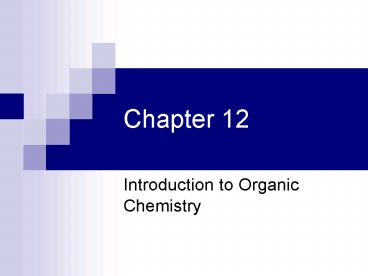Introduction to Organic Chemistry - PowerPoint PPT Presentation
1 / 26
Title:
Introduction to Organic Chemistry
Description:
Organic Chemistry- the study of carbon compounds. Organic Molecules ... The juncture of two lines C atom. Since C has 4 bonds all H's are left out as well ... – PowerPoint PPT presentation
Number of Views:4743
Avg rating:3.0/5.0
Title: Introduction to Organic Chemistry
1
Chapter 12
- Introduction to Organic Chemistry
2
Organic Chemistry
- Organic Chemistry- the study of carbon compounds
3
Organic Molecules
- Carbon is tetravalent always 4 bonds
- Comprised of covalent bonds
- Nonpolar
- Polar
- Polarized molecules
- Single, Double, Triple bonds
- Three dimensional shapes (VSEPR)
- Contain H, N, and O in addition to carbon
4
Properties of Organic Molecules
- Low melting and boiling points
- Few are soluble in water
5
Characterization of Organic Molecules
- Functional Groups
- Characteristic structural feature
- Responsible for chemical behavior
- Compounds with the same functional groups tend to
undergo similar reactions
6
(No Transcript)
7
(No Transcript)
8
Alkanes and Their Isomers
- Alkanes
- hydrocarbons containing only single bonds
- CnH2n2
- Simplest is methane CH4
- Ethane - C2H6
- Carbon forms the backbone
- Propane - C3H8
9
Alkanes and Their Isomers
- C4H10
10
Alkanes and Their Isomers
- Straight chain alkanes
- Branched chain alkanes
- Constitutional isomers same molecular formula
but differing connectivity - Are different compounds with different properties
11
Alkanes and Their Isomers
12
Drawing Organic Structures
- Structural Formula shows every atom and every
bond - Condensed Structures Shorthand way of drawing
structures in which C-C bond and C-H bonds are
understood - Skeletal Structure (Line drawing) Shows the
carbon backbone using lines - The juncture of two lines C atom
- Since C has 4 bonds all Hs are left out as well
13
Shapes of Organic Molecules
- Tetrahedral at each carbon with 4 bonds
- 3 carbon backbone yields only one possible
arrangement 1 type of geometry - 4 carbon straight-chain backbone infinite of
geometries rotation around single bond
conformers - Primary conformation has the least crowded
structure
14
Naming Alkanes
- Use IUPAC naming
- Three parts
- Prefix specifies location of substituents
- Parent indicates the number of carbon atoms in
the longest chain - Suffix identifies what family the molecule
belongs to.
15
Straight Chain Alkanes
- Named according to the of carbon atoms with the
suffix ane.
16
Branched-Chain Alkanes
- Substituents that branch of the main chain are
alkyl groups.
17
Branched-Chain Alkanes
- Methyl and Ethyl groups have only one type of
hydrogen. - More complex for larger groups
18
Branched-Chain Alkanes
- There are 4 possible substitution patterns
19
Branched-Chain Alkanes
- Name the main chain
- Number the atoms in the main chain
- Identify the branching substituents, and number
each - If two substituents are on the same C then assign
the same number to both - Write the name as a single word
- If more than one substituent is present, cite
them in alphabetical order - If two or more identical substituents are
present, use one of the prefixes di-, tri-,
tetra-, and so forth, but do not use these
prefixes for alphabetizing purposes.
20
Properties of Alkanes
- Read Section 12.7, you will be asked a question
on the exam.
21
Reactions of Alkanes
- 2 types
- Combustion
- Halogenation
22
Cycloalkanes
- Cycloalkanes contain a ring of carbons.
23
Cycloalkanes
- Cyclopentane and cyclohexane
24
Drawing and Naming Cycloalkanes
- Even condensed structures become awkward when we
work with large molecules that contain rings. - A more streamlined way of drawing structures is
often used in which cycloalkanes are represented
simply by polygons.
25
Naming Cycloalkanes
- Use the cycloalkane name as the parent
- Identify and number the substituents
- Start numbering at the group with alphabetical
priority - Number the ring so that the substituents have the
lowest possible numbers
26
Homework
- 12.17, 12.18, 12.19, 12.20, 12.21, 12.23, 12.30,
12.31, 12.32, 12.33, 12.39, 12.40, 12.41, 12.42,
12.44, 12.45, 12.46, 12.47, 12.48, 12.49, 12.50,
12.51, 12.52, 12.53, 12.54, 12.55, 12.56, 12.58,
12.59, 12.60, 12.66, 12.67, 12.68, 12.70, 12.71,
12.72

